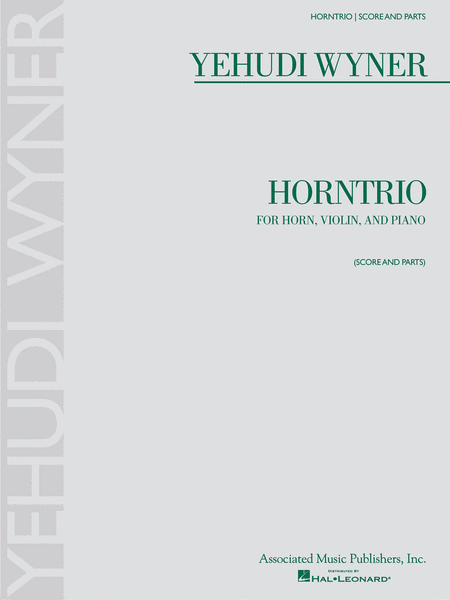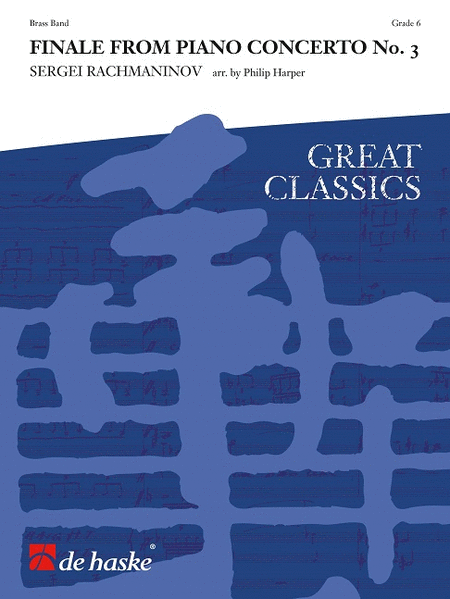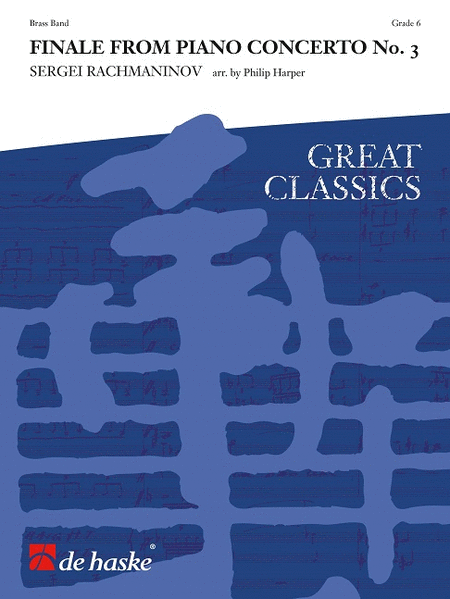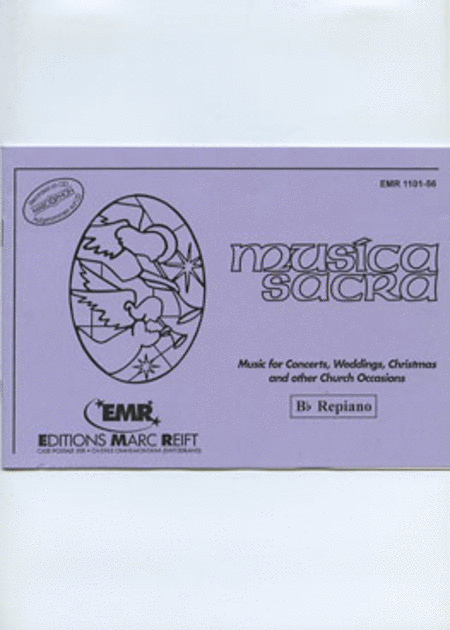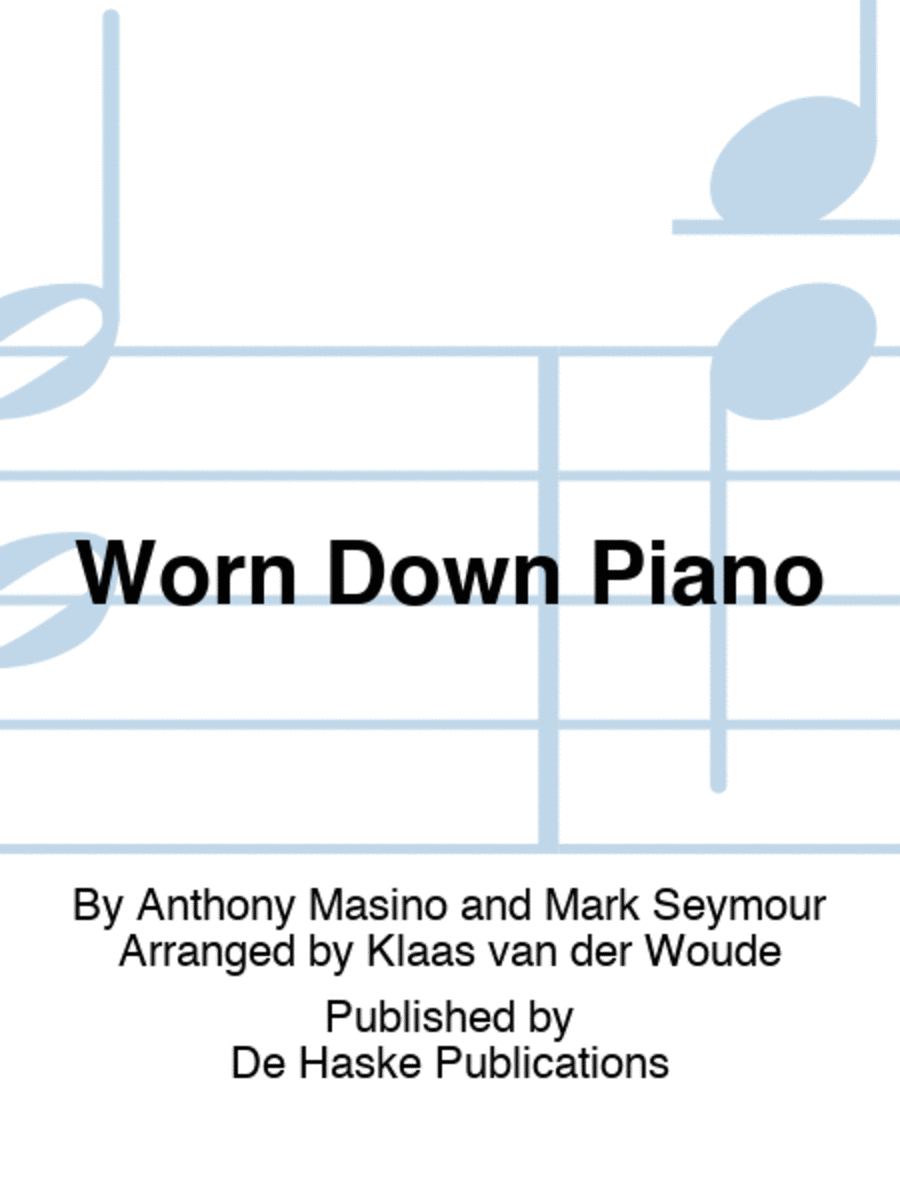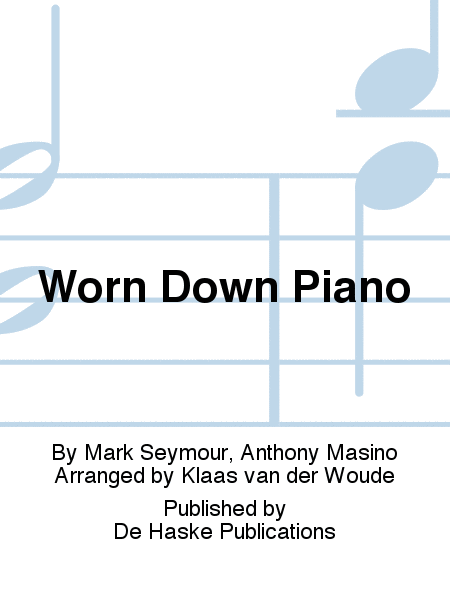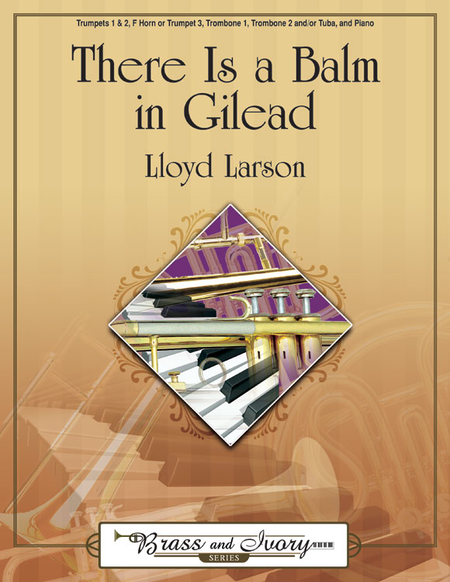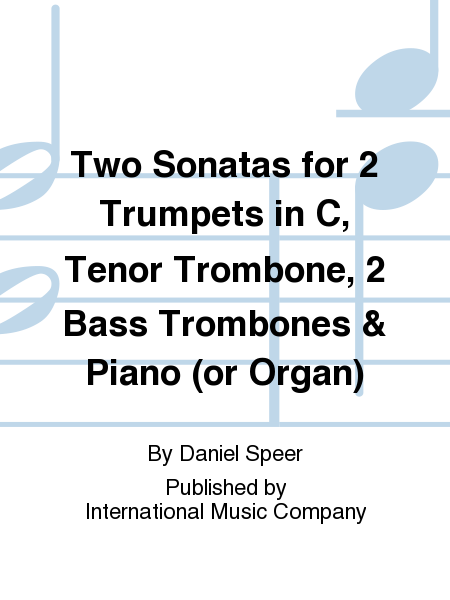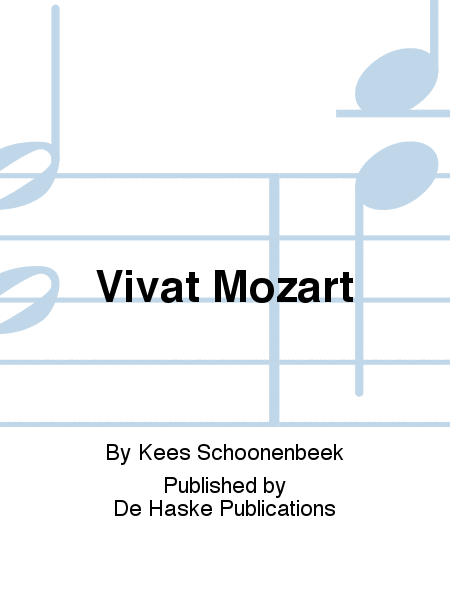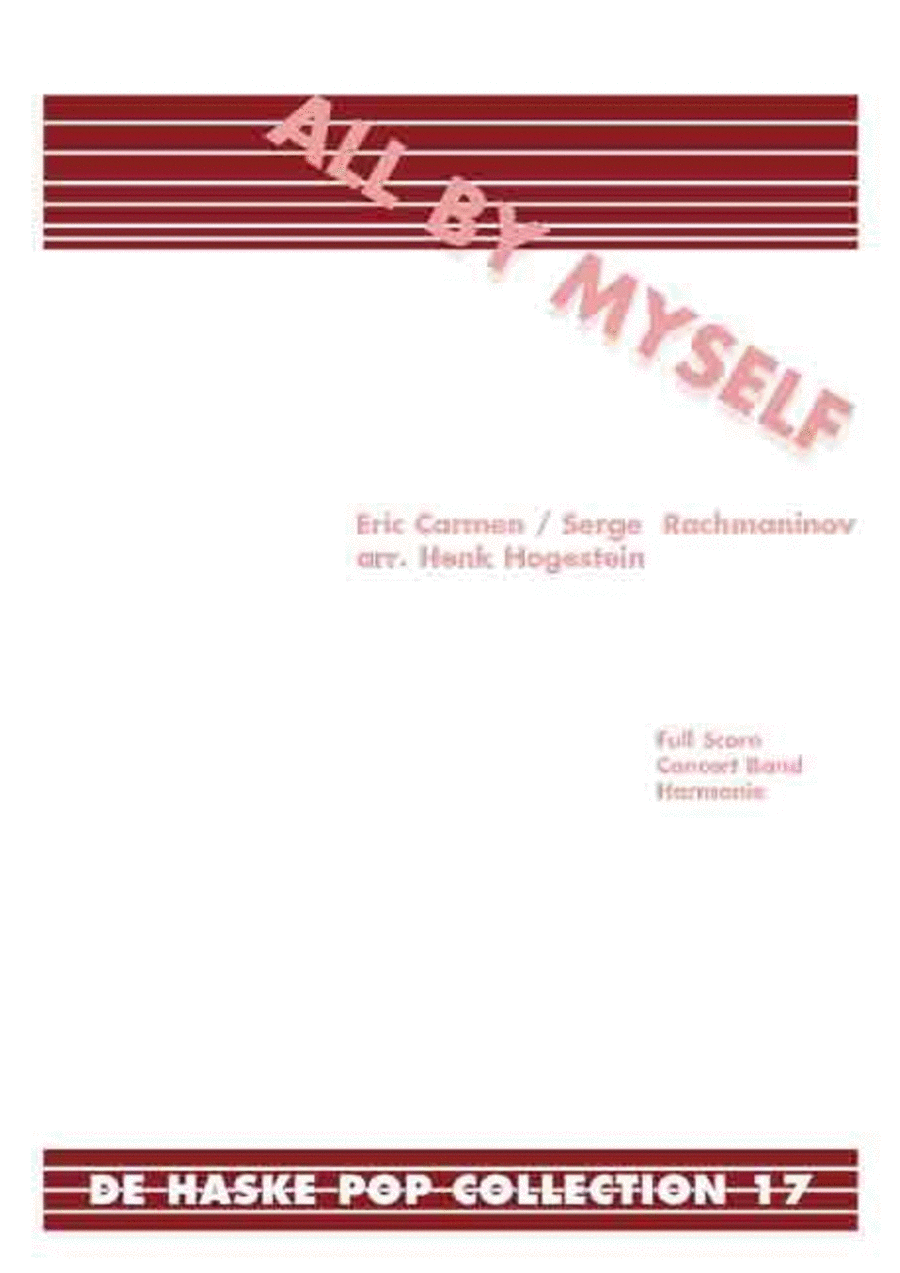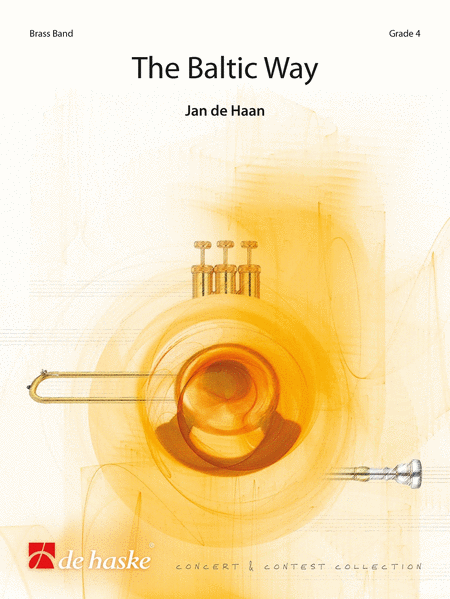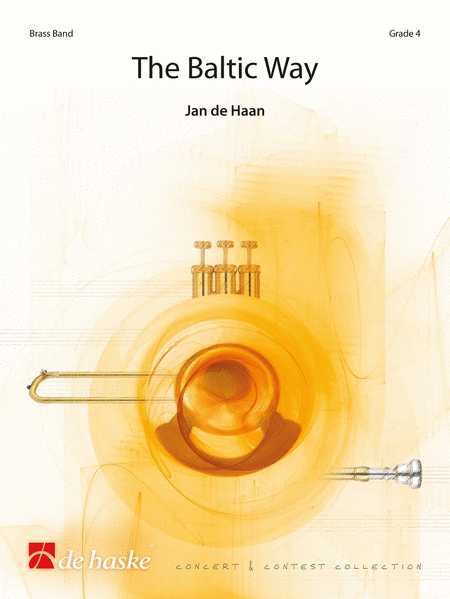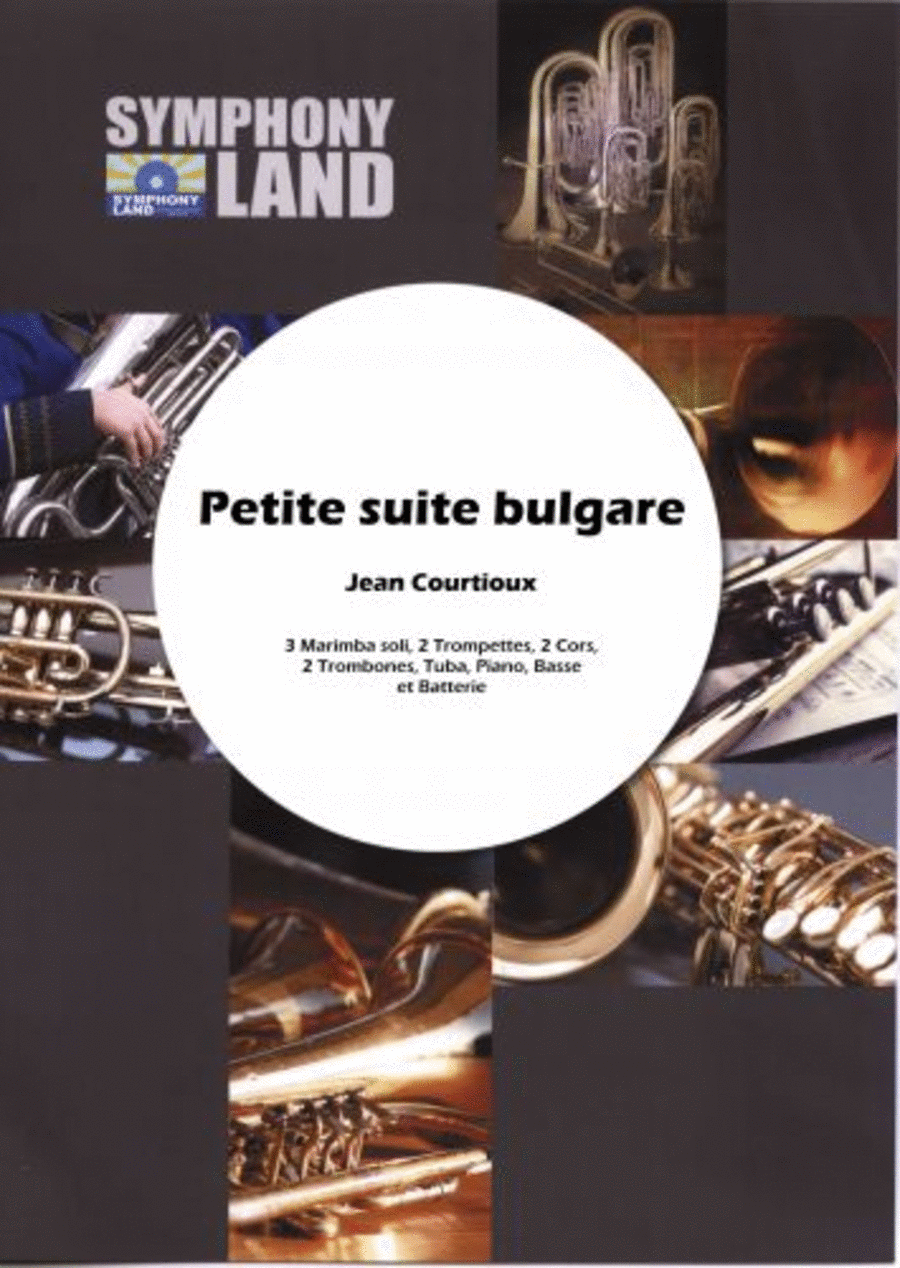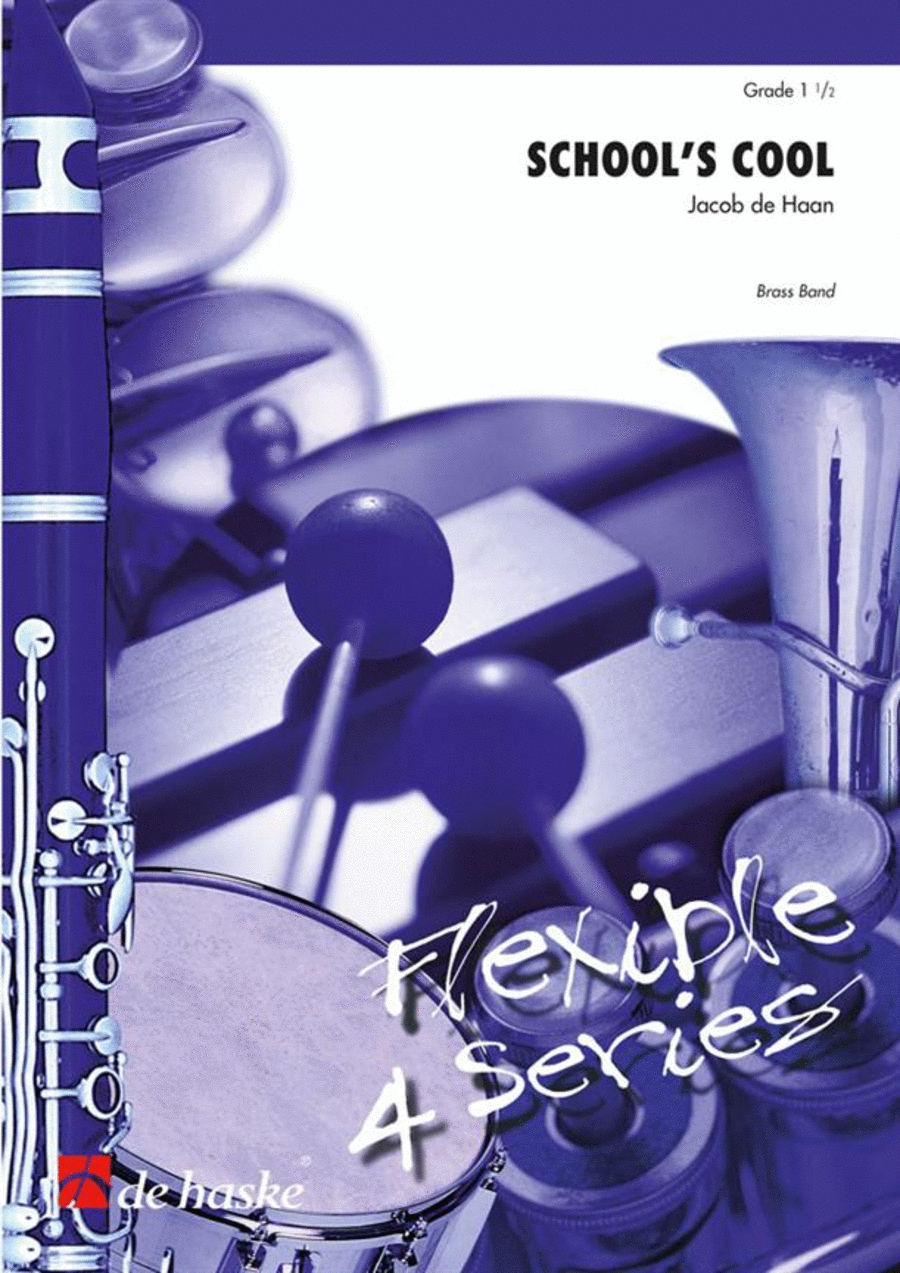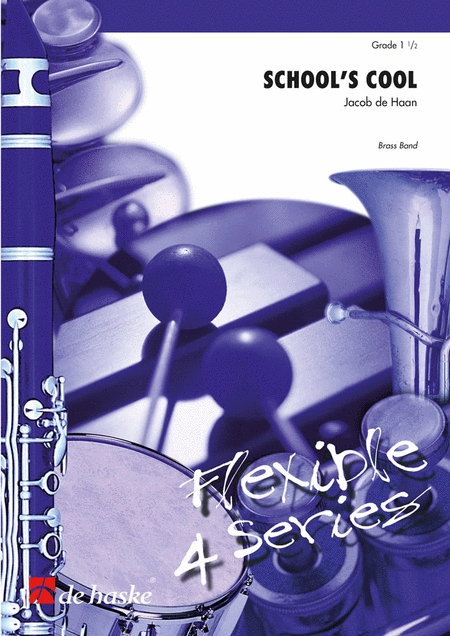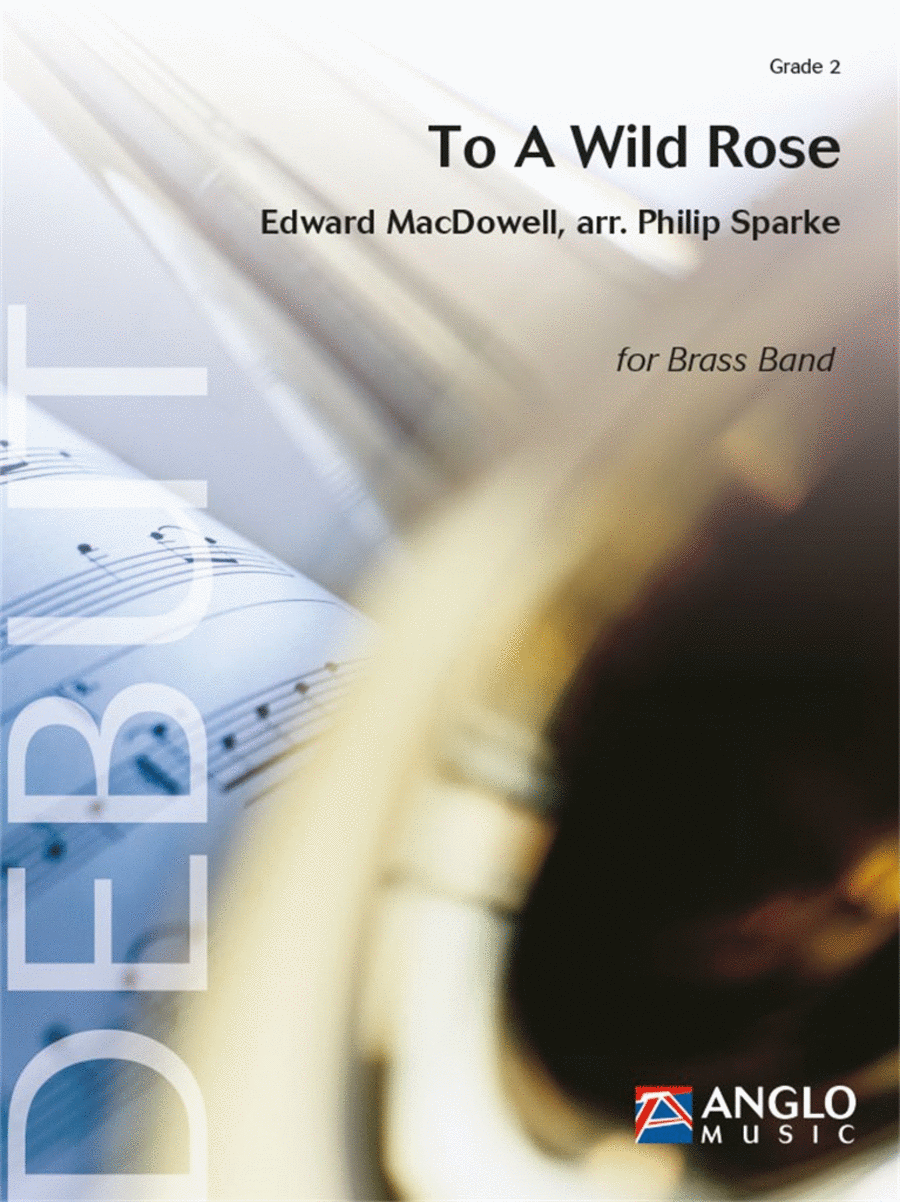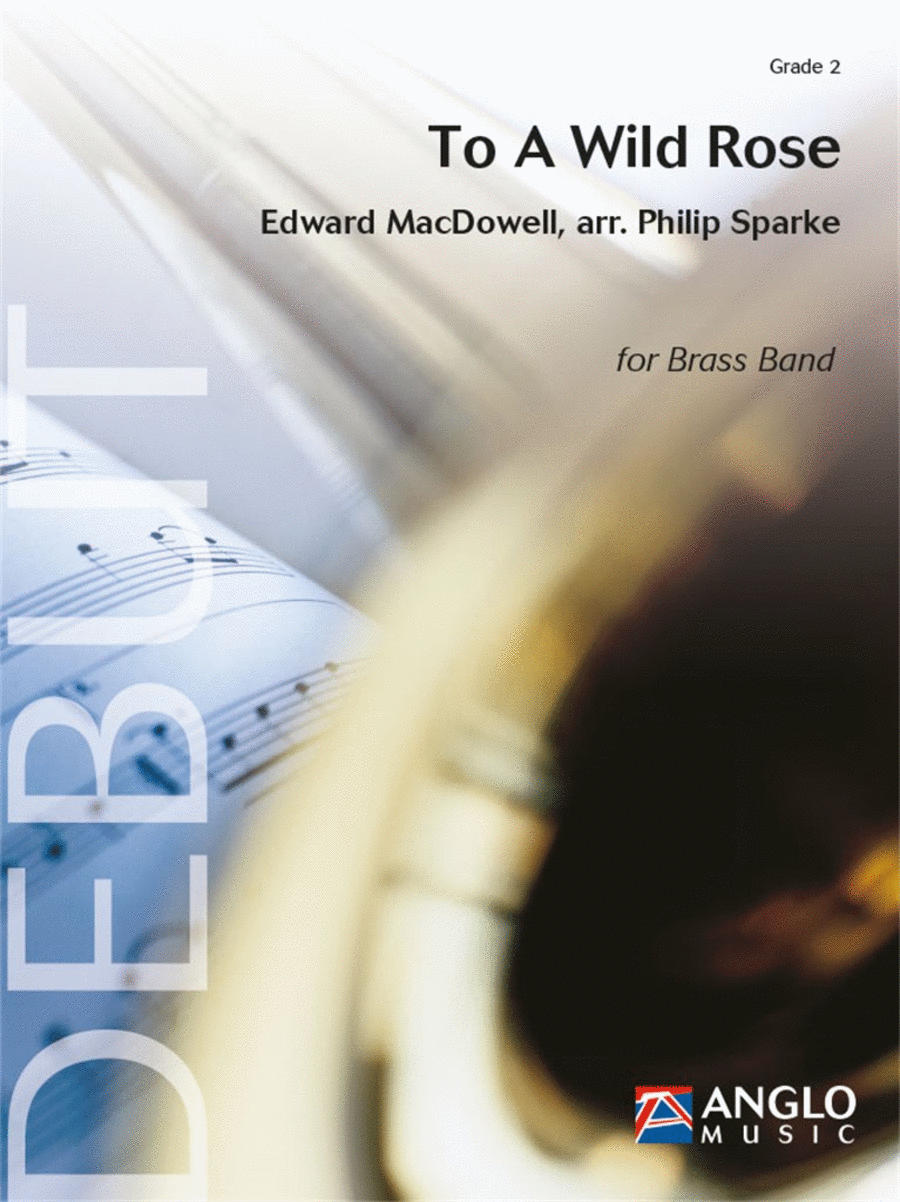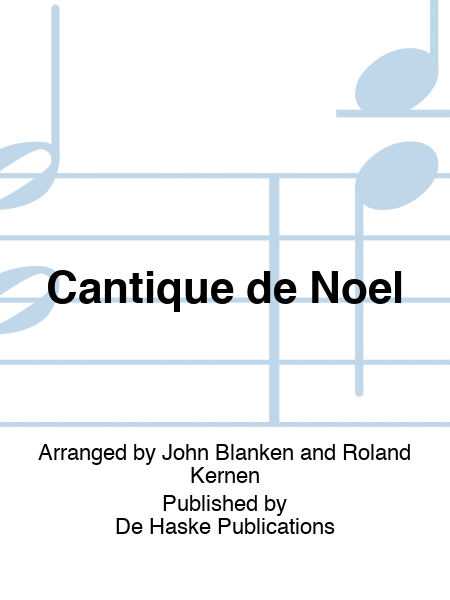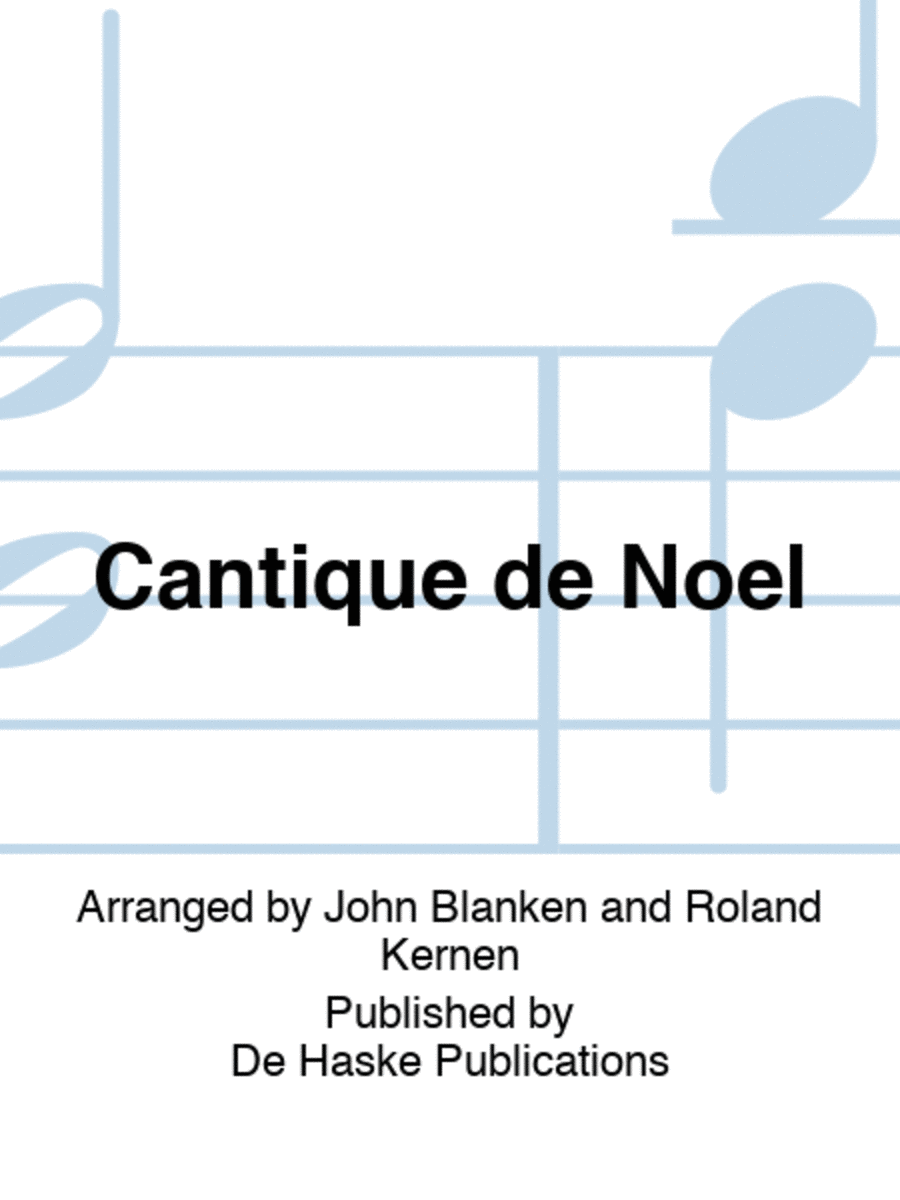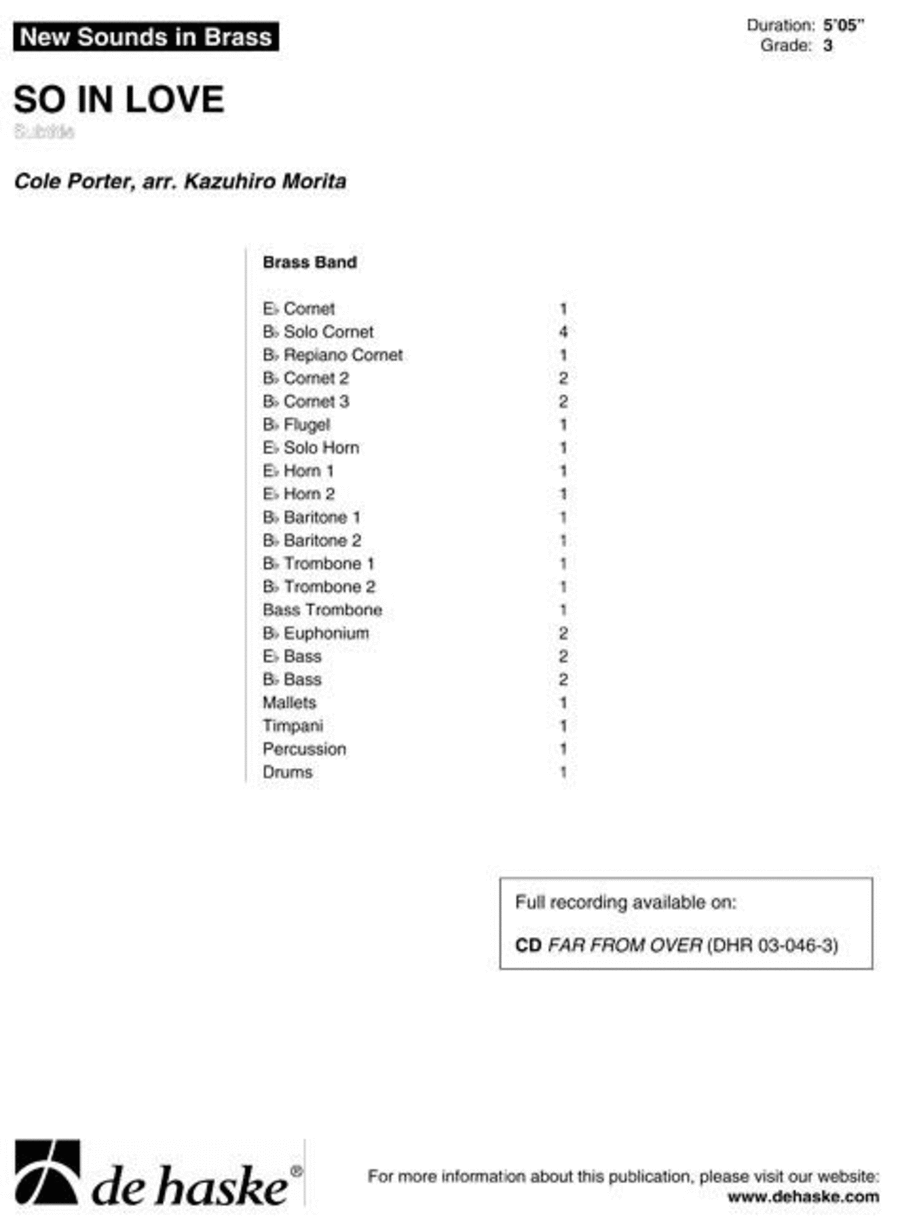|
| Horntrio (Horn, Violin, Piano)
Ensemble de cuivres [Conducteur et Parties séparées]
Associated
For Horn, Violin, and Piano. By Yehudi Wyner. Brass Ensemble. Size 9x12 inches. ...(+)
For Horn, Violin, and
Piano. By Yehudi Wyner.
Brass Ensemble. Size 9x12
inches. Published by
Associated Music
Publishers, Inc.
$35.00 - Voir plus => AcheterDélais: 24 hours - In Stock | | | |
| Finale from Piano Concerto N°3
Ensemble de cuivres [Conducteur] - Intermédiaire/avancé
De Haske Publications
Brass Band - Grade 6 SKU: BT.DHP-1145600-130 Composed by Sergei Rachmanin...(+)
Brass Band - Grade 6
SKU:
BT.DHP-1145600-130
Composed by Sergei
Rachmaninoff. Arranged by
Philip Harper. Great
Classics. Classical.
Score Only. Composed
2014. De Haske
Publications #DHP
1145600-130. Published by
De Haske Publications
(BT.DHP-1145600-130).
English. Philip
Harper has created a
fabulous transcription of
the energetic third
movement of
Rachmaninoff’s
Piano concerto No. 3 in D
minor. This movement is
comprised of variations
on a theme from the first
movement of the concerto.
The final notes would
become
Rachmaninoff’s
musical signature. An
outstanding and very
spectacular title!
Philip Harper
heeft hiermee een
magnifieke transcriptie
van het energieke derde
deel van Rachmaninovs
pianoconcert nr. 3 in
d-klein gecreëerd. Dit
deel bestaat uit
variaties op een thema
uit het eerste deel van
het concert. De laatste
noten zouden Rachmaninovs
muzikale handtekening
worden. Een geweldig,
spectaculair stuk!
Philip Harper
schuf eine fantastische
Bearbeitung des
schwungvollen 3. Satzes
aus Rachmaninows
Klavierkonzert Nr. 3 in
d-Moll. Dieser Satz
besteht aus Variationen
über ein Thema aus dem
1. Satz des Konzertes.
Die Schlusstöne
sollten Rachmaninows
musikalisches
Erkennungszeichen werden.
Ein
außergewöhnlicher,
fantastischer Titel!
Philip Harper a
créé une
transcription formidable
de
l’énergétiqu
e troisième mouvement
du Concerto pour piano
no.3 en ré mineur
de Rachmaninoff. Ce
mouvement comprend des
variations sur un
thème du premier
mouvement de ce concerto.
Les dernières notes
deviendront la signature
musicale de Rachmaninoff.
Un morceau exceptionnel
et très spectaculaire
! $25.95 - Voir plus => AcheterDélais: 2 to 3 weeks | | | |
| Finale from Piano Concerto N°3
Ensemble de cuivres - Intermédiaire/avancé
De Haske Publications
Brass Band - Grade 6 SKU: BT.DHP-1145600-030 Composed by Sergei Rachmanin...(+)
Brass Band - Grade 6
SKU:
BT.DHP-1145600-030
Composed by Sergei
Rachmaninoff. Arranged by
Philip Harper. Great
Classics. Classical. Set
(Score and Parts).
Composed 2014. De Haske
Publications #DHP
1145600-030. Published by
De Haske Publications
(BT.DHP-1145600-030).
English. Philip
Harper has created a
fabulous transcription of
the energetic third
movement of
Rachmaninoffâ??s Piano
concerto No. 3 in D
minor. This movement is
comprised of variations
on a theme from the first
movement of the concerto.
The final notes would
become Rachmaninoffâ??s
musical signature. An
outstanding and very
spectacular title!
Philip Harper
heeft hiermee een
magnifieke transcriptie
van het energieke derde
deel van Rachmaninovs
pianoconcert nr. 3 in
d-klein gecreëerd. Dit
deel bestaat uit
variaties op een thema
uit het eerste deel van
het concert. De laatste
noten zouden Rachmaninovs
muzikale handtekening
worden. Een geweldig,
spectaculair stuk!
Philip Harper
schuf eine fantastische
Bearbeitung des
schwungvollen 3. Satzes
aus Rachmaninows
Klavierkonzert Nr. 3 in
d-Moll. Dieser Satz
besteht aus Variationen
über ein Thema aus dem
1. Satz des Konzertes.
Die Schlusstöne
sollten Rachmaninows
musikalisches
Erkennungszeichen werden.
Ein
au�ergewöhnlicher,
fantastischer Titel!
Philip Harper a
créé une
transcription formidable
de lâ??énergétique
troisième mouvement du
Concerto pour piano
no.3 en ré mineur
de Rachmaninoff. Ce
mouvement comprend des
variations sur un
thème du premier
mouvement de ce concerto.
Les dernières notes
deviendront la signature
musicale de Rachmaninoff.
Un morceau exceptionnel
et très spectaculaire
! $125.95 - Voir plus => AcheterDélais: 2 to 3 weeks | | | |
| Musica Sacra - Bb Repiano
Ensemble de cuivres - Facile
Editions Marc Reift (Swiss import)
By Various. Brass Band. For Bb Repiano. Swiss import. Sacred Music. Level: Grade...(+)
By Various. Brass Band.
For Bb Repiano. Swiss
import. Sacred Music.
Level: Grade 2+. Part.
Published by Editions
Marc Reift. (EMR 1101-56)
$8.95 - Voir plus => AcheterDélais: 3 to 4 weeks | | | |
| Worn Down Piano
Ensemble de cuivres [Conducteur et Parties séparées] - Facile
De Haske Publications
Brass Band - Grade 3 SKU: BT.DHP-1023227-030 Composed by Anthony Masino a...(+)
Brass Band - Grade 3
SKU:
BT.DHP-1023227-030
Composed by Anthony
Masino and Mark Seymour.
Arranged by Klaas van der
Woude. De Haske Pop
Collection. Pop & Rock.
Set (Score & Parts).
Composed 2002. De Haske
Publications #DHP
1023227-030. Published by
De Haske Publications
(BT.DHP-1023227-030).
Worn Down Piano
was a huge hit for the
Mark & Clark Band in
1977. This arrangement by
Klaas van der Woude makes
an entertaining piece
with its tonal contrasts
working exceptionally
well for brass band.
Worn Down
Piano war ein
großer Hit für die
Mark & Clark Band im
Jahre 1977. Klaas van der
Woude nahm sich des
Titels erneut an und
machte daraus ein
schönes Arrangement
für Brass Band. $78.95 - Voir plus => AcheterDélais: 2 to 3 weeks | | | |
| Worn Down Piano
Ensemble de cuivres [Conducteur] - Facile
De Haske Publications
Brass Band - Grade 3 SKU: BT.DHP-1023227-130 Composed by Anthony Masino a...(+)
Brass Band - Grade 3
SKU:
BT.DHP-1023227-130
Composed by Anthony
Masino and Mark Seymour.
Arranged by Klaas van der
Woude. De Haske Pop
Collection. Pop & Rock.
Score Only. Composed
2002. De Haske
Publications #DHP
1023227-130. Published by
De Haske Publications
(BT.DHP-1023227-130).
Worn Down Piano
was a huge hit for the
Mark & Clark Band in
1977. This arrangement by
Klaas van der Woude makes
an entertaining piece
with its tonal contrasts
working exceptionally
well for brass band.
Worn Down
Piano war ein
großer Hit für die
Mark & Clark Band im
Jahre 1977. Klaas van der
Woude nahm sich des
Titels erneut an und
machte daraus ein
schönes Arrangement
für Brass Band. $31.95 - Voir plus => AcheterDélais: 2 to 3 weeks | | | |
| There Is a Balm in Gilead
Ensemble de cuivres
Lorenz Publishing Company
By Lloyd Larson. Instrumental ensemble (brass). For Trumpets 1 and 2, F Horn or ...(+)
By Lloyd Larson.
Instrumental ensemble
(brass). For Trumpets 1
and 2, F Horn or Trumpet
3, Trombone 1, Trombone 2
and/or Tuba, and Piano.
Brass and Ivory Series.
Published by Lorenz
Publishing Company
$22.95 - Voir plus => AcheterDélais: 1 to 2 weeks | | | |
| Two Sonatas for 2 Trumpets in C, Tenor Trombone, 2 Bass Trombones and Piano (or Organ)
Ensemble de cuivres
IMC (International Music Co.)
By Daniel Speer. Edited by Keith Brown. For 2 trumpets in C, tenor trombone, 2 b...(+)
By Daniel Speer. Edited
by Keith Brown. For 2
trumpets in C, tenor
trombone, 2 bass
trombones and piano (or
organ). Published by
International Music
Company
$14.50 - Voir plus => AcheterDélais: 1 to 2 weeks | | | |
| Vivat Mozart
Ensemble de cuivres [Conducteur et Parties séparées] - Facile
De Haske Publications
Brass Band - Grade 2 SKU: BT.DHP-0900197-030 Variations on KV 503....(+)
Brass Band - Grade 2
SKU:
BT.DHP-0900197-030
Variations on KV
503. Composed by Kees
Schoonenbeek. Flexible 5
Series. March. Set (Score
& Parts). Composed 1990.
De Haske Publications
#DHP 0900197-030.
Published by De Haske
Publications
(BT.DHP-0900197-030).
Vivat
Mozart werd als thema
met variaties
gecomponeerd. Als
uitgangspunt gebruikte
Kees Schoonenbeek het
openingsthema van Mozarts
pianoconcert KV 503.
Daarover ontwikkelde hij
veelzijdige muzikale
ideeën, van de
originelestijl tot aan de
blues voerend. Het gaat
hier om een typische
Mozart-melodie:
natuurlijk, direct, bijna
volksliedachtig en heel
expressief.
Viv
at Mozart wurde als
Thema mit Variationen
komponiert. Ausgangspunkt
war das Eingangsthema des
dritten Satzes aus
Mozarts Klavierkonzert
in C (KV 503). Daraus
wurden sehr vielseitige
musikalische Ideen, die
vom volksliedartigen Stil
der Originalmelodie bis
hin zum Blues führen,
entwickelt. Vivat Mozart
setzt sich auf
vergnügliche Weise mit
der Musik eines großen
Meisters auseinander und
eignet sich ausgezeichnet
dazu, diesen Ihren jungen
Musikern nahe zu
bringen.
En
associant son talent de
compositeur sa grande
créativité, Kees
Schoonenbeek a créé
Vivat Mozart, une
œuvre délicate et
fluide en forme de
variations sur le
Concerto pour piano KV
503 du génie de
Salzbourg, Wolfgang
Amadeus Mozart. $72.95 - Voir plus => AcheterDélais: 2 to 3 weeks | | | |
| All by Myself
Ensemble de cuivres [Conducteur et Parties séparées] - Facile
De Haske Publications
Brass Band - Grade 2 SKU: BT.DHP-0970834-030 Composed by Eric Carmen and ...(+)
Brass Band - Grade 2
SKU:
BT.DHP-0970834-030
Composed by Eric Carmen
and Sergei Rachmaninoff.
Arranged by Henk
Hogestein. De Haske Pop
Collection. Pop & Rock.
Set (Score & Parts).
Composed 1997. De Haske
Publications #DHP
0970834-030. Published by
De Haske Publications
(BT.DHP-0970834-030).
All by
Myself, de gevoelige
song van Eric Carmen (ook
vertolkt door Céline
Dion), is wereldwijd
bekend, maar weinigen
weten dat de melodie
afkomstig is uit het
Tweede Pianoconcert van
de Russische componist
Sergei Rachmaninov.Henk
Hogestein heeft het
klassieke thema verwerkt
in een mooie, gedragen
versie voor
blaasorkest.
Nombr
eux sont ceux qui
connaissent cette superbe
ballade interprétée
par Céline Dion. Mais
peu de gens savent que la
mélodie originale
provient du deuxième
mouvement du Concerto
pour piano n° 2 du
compositeur et pianiste
russe Sergue Rachmaninov,
une œuvre magistrale
dont le succès lui a
assuré une renommée
internationale.
C’est avec finesse
et élégance que
Henk Hogestein a
arrangé ce thème
classique que tout le
monde peut fredonner. $72.95 - Voir plus => AcheterDélais: 2 to 3 weeks | | | |
| The Baltic Way
Ensemble de cuivres [Conducteur] - Intermédiaire
De Haske Publications
Brass Band - Grade 4 SKU: BT.DHP-1206253-130 Composed by Jan de Haan. Con...(+)
Brass Band - Grade 4
SKU:
BT.DHP-1206253-130
Composed by Jan de Haan.
Concert and Contest
Collection Brass Band en
Fanfare. Concert Piece.
Score Only. Composed
2019. 48 pages. De Haske
Publications #DHP
1206253-130. Published by
De Haske Publications
(BT.DHP-1206253-130).
English-German-French-
Dutch. In 1989, the
demonstration named the
Baltic Way also
known as the Baltic
Chain— was held in
the Baltic states of
Estonia, Latvia and
Lithuania by its citizens
in a call for
independence from the
Soviet Union. On 23rd
August 1989, some two
million participants
formed a human chain,
hand-in-hand all the way
from the Estonian capital
of Tallinn its Latvian
counterpart, Riga,
through to the Lithuanian
capital of Vilnius - six
hundred kilometres long.
It became the longest
human chain ever created
and turned out to be the
final push needed for
much sought-after
independence. This
historic event became the
source of inspiration for
this composition. The
introduction of thefirst
movement, ‘Struggle
for Independence’,
is based on a nocturne
for piano by the renowned
Lithuanian composer and
painter Mikalojus
Konstantinas iurlionis
(1875-1911), thematic
material from which has
been incorporated
throughout the whole
composition. The
melancholic beginning is
followed by a powerful
theme which reflects the
resolve of the Baltic
people. The sudden
aggressive, dissonant
chords and a dominant
and—in rhythmic
terms—contrary
bass drum announce that
the resistance is not
going smoothly. Just for
a moment, we hear the
anthem of the Soviet
Union in the lower brass,
but this is relentlessly
pushed to the background
by the rest of the band
playing the Lithuanian
national anthem,
‘Tautiška giesm
’ (Lithuania, our
homeland). The second
movement, ‘Decades
of Suffering’,
echoes life under the
Soviet Union's thumb. In
the pursuit of
independence, a peaceful
protest is planned in
which a human chain is
formed across the Baltic
states of Estonia, Latvia
and Lithuania. This
‘Chain of
Freedom’ is
depicted in the final
movement of the work.
De Baltische Weg
(The Baltic Way)
was een demonstratie van
de bevolking van de
Baltische staten die in
1989 plaatsvond als een
roep om onafhankelijkheid
van de Sovjet-Unie. Deze
historische gebeurtenis
vormde de inspiratiebron
voor deze compositie. Van
Vilnius via Riga naar
Tallinn werd een
zeshonderd kilometer
lange keten van naar
schatting twee miljoen
mensen gevormd. Op 23
augustus 1989 gaven al
die mensen elkaar de hand
en werd De Baltische Weg
de langste menselijke
keten ooit. Het bleek de
uiteindelijke opmaat tot
de zo gewenste
onafhankelijkheid. De
inleiding van het eerste
deel, ‘Struggle for
Independence’, is
gebaseerd op een nocturne
voor piano van
devooraanstaande Litouwse
componist en
kunstschilder Mikalojus
Konstantinas iurlionis
(1875-1911). Het
thematische materiaal van
deze nocturne is door de
hele compositie heen
verwerkt. Na het
melancholische begin
volgt een krachtig thema,
waarmee de strijdbaarheid
van de Baltische
bevolking wordt
uitgebeeld. De
plotselinge agressieve
dissonante akkoorden en
een dominante en ritmisch
gezien tegendraadse grote
trom laten horen dat het
verzet niet eenvoudig
verloopt. Even klinkt het
begin van het volkslied
van de Sovjet-Unie in het
lage koper, maar dat
wordt door de rest van de
band onverbiddelijk naar
de achtergrond verwezen
door het Litouwse
nationale volkslied
‘Tautiška giesm
’ (Litouwen, ons
vaderland). In deel twee,
‘Decades of
Suffering’, wordt
het leven onder het juk
van de Sovjet-Unie
verklankt. In het streven
naar onafhankelijkheid
worden plannen gemaakt om
als vreedzaam protest
tegen de onderdrukking
een menselijke keten te
vormen over de wegen van
de Baltische staten
Litouwen, Letland en
Estland. Deze
‘Chain of
Freedom’ wordt in
het laatste deel van het
werk muzikaal
weergegeven.
Der
sogenannte Baltischer Weg
(The Baltic Way)
auch unter dem Namen
Baltische Kette bekannt
war 1989 eine
Demonstration von
Bürgern in den
baltischen Staaten
Estland, Lettland und
Litauen mit dem Aufruf
zur Unabhängigkeit von
der Sowjetunion. Am 23.
August 1989 bildeten rund
zwei Millionen Teilnehmer
eine sechshundert
Kilometer lange
Menschenkette, die von
der estnischen Hauptstadt
Tallinn über das
lettische Riga bis zur
litauischen Hauptstadt
Vilnius reichte. Die
längste Menschenkette,
die jemals geschaffen
wurde, erwies sich als
der letzte Schritt, der
zur lang ersehnten
Unabhängigkeit
führte. Dieses
historische Ereignis
diente der Komposition
alsInspirationsquelle.
Die Einleitung des ersten
Satzes, Struggle for
Independence“,
basiert auf einem
Nocturne für Klavier
des bekannten litauischen
Komponisten und Malers
Mikalojus Konstantinas
iurlionis (1875 1911),
dessen thematisches
Material in der gesamten
Komposition verwendet
wird. Dem melancholischen
Anfang folgt ein
mitreißendes Thema,
das die Entschlossenheit
der baltischen
Bevölkerung
widerspiegelt. Die
plötzlichen
aggressiven, dissonanten
Akkorde und eine
dominante und rhythmisch
gegenläufige Bewegung
in der Basstrommel
kündigen an, dass der
Widerstand nicht
reibungslos verläuft.
Für einen kurzen
Moment erklingt die Hymne
der Sowjetunion in den
tiefen Blechbläsern,
aber diese wird
unerbittlich vom
restlichen Orchester in
den Hintergrund
gedrängt, welches die
litauische Nationalhymne
Tautiška giesm “
(Litauen, unser
Heimatland“)
spielt. Der zweite Satz,
Decades of
Suffering“,
spiegelt das Leben unter
dem Joch der Sowjetunion
wider. Für das Streben
nach Unabhängigkeit
war ein friedlicher
Protest geplant, bei dem
eine Menschenkette durch
die baltischen Staaten
Estland, Lettland und
Litauen gebildet wurde.
Diese Chain of
Freedom“ wird im
letzten Satz des Werkes
beschrieben.
En
1989, la manifestation
nommée « La Voie
balte » (The Baltic
Way) s’est
tenue en Estonie, en
Lettonie et en Lituanie,
les pays baltes dont les
citoyens demandaient
être indépendants
de l’Union
soviétique. Le 23 ao t
1989, quelque deux
millions de personnes se
tenant par la main ont
formé une chaîne
humaine de 600 km de long
reliant les trois
capitales Tallinn
(Estonie), Riga
(Lettonie) et Vilnius
(Lituanie). Cette
chaîne humaine, la
plus longue ce jour,
donna une impulsion
décisive au
rétablissement
d’une
indépendance vivement
souhaitée. Cet
événement
historique est devenu
source
d’inspiration pour
cette composition.
L’introduction du
premier mouvement,«
Struggle for Independence
», est fondée sur
un nocturne pour piano du
célèbre compositeur
et peintre letton
Mikalojus Konstantinas
iurlionis (1875-1911). Du
matériel thématique
emprunté ce nocturne
est parsemé travers la
présente composition.
Un début
mélancolique est suivi
d’un thème
puissant qui reflète
la détermination des
peuples baltes. La
présence soudaine
d’accords
agressifs et dissonants,
associés une grosse
caisse dont le
décalage rythmique
domine, indiquent que la
résistance rencontre
des obstacles. Nous
entendons
momentanément
l’hymne
soviétique dans les
cuivres graves, mais cet
air est inexorablement
repoussé
l’arrière-plan
par le reste de
l’orchestre
interprétant
l’hymne national
de Lettonie, «
Tautiška giesm »
(Lettonie, notre patrie).
Le deuxième mouvement,
« Decades of Suffering
», dépeint la vie
sous le joug de
l’Union
soviétique. la
recherche de
l’indépendance,
une manifestation
pacifique est
organisée sous la
forme d’une
chaîne humaine
traversant les trois pays
baltes l ’Estonie,
la Lettonie et la
Lituanie. Le dernier
mouvement de la pièce,
« Chain of Freedom
», exprime cet appel
la liberté. $30.95 - Voir plus => AcheterDélais: 2 to 3 weeks | | | |
| The Baltic Way
Ensemble de cuivres [Conducteur et Parties séparées] - Intermédiaire
De Haske Publications
Brass Band - Grade 4 SKU: BT.DHP-1206253-030 Composed by Jan de Haan. Con...(+)
Brass Band - Grade 4
SKU:
BT.DHP-1206253-030
Composed by Jan de Haan.
Concert and Contest
Collection Brass Band en
Fanfare. Concert Piece.
Set (Score & Parts).
Composed 2019. De Haske
Publications #DHP
1206253-030. Published by
De Haske Publications
(BT.DHP-1206253-030).
English-German-French-
Dutch. In 1989, the
demonstration named the
Baltic Way also
known as the Baltic
Chain— was held in
the Baltic states of
Estonia, Latvia and
Lithuania by its citizens
in a call for
independence from the
Soviet Union. On 23rd
August 1989, some two
million participants
formed a human chain,
hand-in-hand all the way
from the Estonian capital
of Tallinn its Latvian
counterpart, Riga,
through to the Lithuanian
capital of Vilnius - six
hundred kilometres long.
It became the longest
human chain ever created
and turned out to be the
final push needed for
much sought-after
independence. This
historic event became the
source of inspiration for
this composition. The
introduction of thefirst
movement, ‘Struggle
for Independence’,
is based on a nocturne
for piano by the renowned
Lithuanian composer and
painter Mikalojus
Konstantinas iurlionis
(1875-1911), thematic
material from which has
been incorporated
throughout the whole
composition. The
melancholic beginning is
followed by a powerful
theme which reflects the
resolve of the Baltic
people. The sudden
aggressive, dissonant
chords and a dominant
and—in rhythmic
terms—contrary
bass drum announce that
the resistance is not
going smoothly. Just for
a moment, we hear the
anthem of the Soviet
Union in the lower brass,
but this is relentlessly
pushed to the background
by the rest of the band
playing the Lithuanian
national anthem,
‘Tautiška giesm
’ (Lithuania, our
homeland). The second
movement, ‘Decades
of Suffering’,
echoes life under the
Soviet Union's thumb. In
the pursuit of
independence, a peaceful
protest is planned in
which a human chain is
formed across the Baltic
states of Estonia, Latvia
and Lithuania. This
‘Chain of
Freedom’ is
depicted in the final
movement of the work.
De Baltische Weg
(The Baltic Way)
was een demonstratie van
de bevolking van de
Baltische staten die in
1989 plaatsvond als een
roep om onafhankelijkheid
van de Sovjet-Unie. Deze
historische gebeurtenis
vormde de inspiratiebron
voor deze compositie. Van
Vilnius via Riga naar
Tallinn werd een
zeshonderd kilometer
lange keten van naar
schatting twee miljoen
mensen gevormd. Op 23
augustus 1989 gaven al
die mensen elkaar de hand
en werd De Baltische Weg
de langste menselijke
keten ooit. Het bleek de
uiteindelijke opmaat tot
de zo gewenste
onafhankelijkheid. De
inleiding van het eerste
deel, ‘Struggle for
Independence’, is
gebaseerd op een nocturne
voor piano van
devooraanstaande Litouwse
componist en
kunstschilder Mikalojus
Konstantinas iurlionis
(1875-1911). Het
thematische materiaal van
deze nocturne is door de
hele compositie heen
verwerkt. Na het
melancholische begin
volgt een krachtig thema,
waarmee de strijdbaarheid
van de Baltische
bevolking wordt
uitgebeeld. De
plotselinge agressieve
dissonante akkoorden en
een dominante en ritmisch
gezien tegendraadse grote
trom laten horen dat het
verzet niet eenvoudig
verloopt. Even klinkt het
begin van het volkslied
van de Sovjet-Unie in het
lage koper, maar dat
wordt door de rest van de
band onverbiddelijk naar
de achtergrond verwezen
door het Litouwse
nationale volkslied
‘Tautiška giesm
’ (Litouwen, ons
vaderland). In deel twee,
‘Decades of
Suffering’, wordt
het leven onder het juk
van de Sovjet-Unie
verklankt. In het streven
naar onafhankelijkheid
worden plannen gemaakt om
als vreedzaam protest
tegen de onderdrukking
een menselijke keten te
vormen over de wegen van
de Baltische staten
Litouwen, Letland en
Estland. Deze
‘Chain of
Freedom’ wordt in
het laatste deel van het
werk muzikaal
weergegeven.
Der
sogenannte Baltischer Weg
(The Baltic Way)
auch unter dem Namen
Baltische Kette bekannt
war 1989 eine
Demonstration von
Bürgern in den
baltischen Staaten
Estland, Lettland und
Litauen mit dem Aufruf
zur Unabhängigkeit von
der Sowjetunion. Am 23.
August 1989 bildeten rund
zwei Millionen Teilnehmer
eine sechshundert
Kilometer lange
Menschenkette, die von
der estnischen Hauptstadt
Tallinn über das
lettische Riga bis zur
litauischen Hauptstadt
Vilnius reichte. Die
längste Menschenkette,
die jemals geschaffen
wurde, erwies sich als
der letzte Schritt, der
zur lang ersehnten
Unabhängigkeit
führte. Dieses
historische Ereignis
diente der Komposition
alsInspirationsquelle.
Die Einleitung des ersten
Satzes, Struggle for
Independence“,
basiert auf einem
Nocturne für Klavier
des bekannten litauischen
Komponisten und Malers
Mikalojus Konstantinas
iurlionis (1875 1911),
dessen thematisches
Material in der gesamten
Komposition verwendet
wird. Dem melancholischen
Anfang folgt ein
mitreißendes Thema,
das die Entschlossenheit
der baltischen
Bevölkerung
widerspiegelt. Die
plötzlichen
aggressiven, dissonanten
Akkorde und eine
dominante und rhythmisch
gegenläufige Bewegung
in der Basstrommel
kündigen an, dass der
Widerstand nicht
reibungslos verläuft.
Für einen kurzen
Moment erklingt die Hymne
der Sowjetunion in den
tiefen Blechbläsern,
aber diese wird
unerbittlich vom
restlichen Orchester in
den Hintergrund
gedrängt, welches die
litauische Nationalhymne
Tautiška giesm “
(Litauen, unser
Heimatland“)
spielt. Der zweite Satz,
Decades of
Suffering“,
spiegelt das Leben unter
dem Joch der Sowjetunion
wider. Für das Streben
nach Unabhängigkeit
war ein friedlicher
Protest geplant, bei dem
eine Menschenkette durch
die baltischen Staaten
Estland, Lettland und
Litauen gebildet wurde.
Diese Chain of
Freedom“ wird im
letzten Satz des Werkes
beschrieben.
En
1989, la manifestation
nommée « La Voie
balte » (The Baltic
Way) s’est
tenue en Estonie, en
Lettonie et en Lituanie,
les pays baltes dont les
citoyens demandaient
être indépendants
de l’Union
soviétique. Le 23 ao t
1989, quelque deux
millions de personnes se
tenant par la main ont
formé une chaîne
humaine de 600 km de long
reliant les trois
capitales Tallinn
(Estonie), Riga
(Lettonie) et Vilnius
(Lituanie). Cette
chaîne humaine, la
plus longue ce jour,
donna une impulsion
décisive au
rétablissement
d’une
indépendance vivement
souhaitée. Cet
événement
historique est devenu
source
d’inspiration pour
cette composition.
L’introduction du
premier mouvement,«
Struggle for Independence
», est fondée sur
un nocturne pour piano du
célèbre compositeur
et peintre letton
Mikalojus Konstantinas
iurlionis (1875-1911). Du
matériel thématique
emprunté ce nocturne
est parsemé travers la
présente composition.
Un début
mélancolique est suivi
d’un thème
puissant qui reflète
la détermination des
peuples baltes. La
présence soudaine
d’accords
agressifs et dissonants,
associés une grosse
caisse dont le
décalage rythmique
domine, indiquent que la
résistance rencontre
des obstacles. Nous
entendons
momentanément
l’hymne
soviétique dans les
cuivres graves, mais cet
air est inexorablement
repoussé
l’arrière-plan
par le reste de
l’orchestre
interprétant
l’hymne national
de Lettonie, «
Tautiška giesm »
(Lettonie, notre patrie).
Le deuxième mouvement,
« Decades of Suffering
», dépeint la vie
sous le joug de
l’Union
soviétique. la
recherche de
l’indépendance,
une manifestation
pacifique est
organisée sous la
forme d’une
chaîne humaine
traversant les trois pays
baltes l ’Estonie,
la Lettonie et la
Lituanie. Le dernier
mouvement de la pièce,
« Chain of Freedom
», exprime cet appel
la liberté. $137.95 - Voir plus => AcheterDélais: 2 to 3 weeks | | | |
| Petite suite bulgare 3 marimba soli2 trompettes , 2 cors , 2 trombones, 1 tubapiano, basse, batterie
Ensemble de cuivres - Facile
Martin, Robert
Brass ensemble - Grade 3 SKU: RM.SL10674 Composed by Jean Courtioux. Ense...(+)
Brass ensemble - Grade 3
SKU: RM.SL10674
Composed by Jean
Courtioux. Ensemble de
brass. Chamber music.
Duration 10 minutes, 30
seconds. Editions Robert
Martin #SL10674.
Published by Editions
Robert Martin
(RM.SL10674). ISBN
9790231096743. $65.95 - Voir plus => AcheterDélais: 4 to 6 weeks | | | |
| School's Cool
Ensemble de cuivres [Conducteur et Parties séparées] - Débutant
De Haske Publications
Brass Band - Grade 1.5 SKU: BT.DHP-1053829-030 Little Suite for Flexib...(+)
Brass Band - Grade 1.5
SKU:
BT.DHP-1053829-030
Little Suite for
Flexible Band.
Composed by Jacob De
Haan. Flexible 4 Series.
Concert Piece. Set (Score
& Parts). Composed 2005.
De Haske Publications
#DHP 1053829-030.
Published by De Haske
Publications
(BT.DHP-1053829-030).
9x12 inches.
English-German-French-Dut
ch. This short,
“cool†suite
in three movements can be
performed with a variety
of instruments from a
handful of players to a
complete brass band. The
first movement radiates
joy with a powerful 3/4
beat. The second movement
is in the style of a
pavane, which gives a
sense of nostalgia and
the final movement forms
a cheerful and
high-spirited closing
with a really funky beat.
This wonderful suite has
been composed especially
for youth musicians and
they will all gain great
pleasure from performing
it.
Deze korte
suite is uitvoerbaar in
elke denkbare bezetting
(eventueel inclusief
piano).
School’s
Cool is gecomponeerd
in opdracht van de Yamaha
Bläserklasse van de
Frauenwaldschule in
Nieder-Mörlen
(Duitsland), ter
gelegenheidvan de
verhuizing naar een ander
gebouw. De leerlingen van
het orkest vonden de
voormalige school
‘cool’,
omdat ze er fijn konden
musiceren. Het eerste
deel straalt deze vreugde
uit met een krachtige
beat in driekwartsmaat.
Hettweede deel is een
soort pavane, waarin even
wat weemoed doorklinkt.
Het derde deel vormt een
levenslustig slot in een
lekkere funkbeat. Een
heerlijke suite voor
jeugdige
musici.
Diese
kurze, coole“ Suite
in drei Sätzen wurde
speziell für eine hoch
motivierte
Bläserklasse
komponiert und kann
deshalb in jeder
denkbaren Spielstärke
(optional mit Klavier)
gespielt werden. Der
erste Satz strahlt
Spielfreude in einem
kraftvollen Rhythmus im
1/2-Takt aus. Der zweite
Satz ist eine Art Pavane,
in welcher einen Moment
lang Nostalgie
widerklingt. Der dritte
Satz bildet ein
fröhliches, in
Hochstimmung endendes
Finale in einem
ansprechenden Funk-Beat.
Kurz gesagt, ist
School’s
Cool eine wunderbare
Suite, ganz besonders
für junge
Musiker.
Cette
petite suite fluide et
détendue en trois
mouvements est adaptée
tous types de formations
géométrie variable
(partie de piano
optionnelle). Le premier
mouvement évoque la
joie de vivre en musique.
Le deuxième mouvement
est une sorte de pavane
empreinte de nostalgie.
Enjoué et
pétillant, le
troisième mouvement
conclut
l’œuvre sur
un rythme funk
entraînant. Cette
petite suite charmante
est parfaite pour vos
jeunes musiciens.
Questa piccola
suite in tre movimenti,
fluida e rilassante, è
adatta ad ogni tipo di
organico a strumentazione
variabile (parte per il
piano opzionale).
School’s
Cool è un brano
commissionato a Jacob de
Haan per la classe di
musica Essential Elements
della Scuola Frauenwald
di Nieder-Mörlen in
Germania. Il primo
movimento evoca
musicalmente la gioia di
vivere. Il secondo
movimento è una specie
di pavane impregnata di
nostalgia. Vivace e
brillante, il terzo
movimento chiude il brano
su un trascinante ritmo
funk. Questa piccola
suite piena di charme
è perfetta per giovani
musicisti. $72.95 - Voir plus => AcheterDélais: 2 to 3 weeks | | | |
| School's Cool
Ensemble de cuivres [Conducteur] - Débutant
De Haske Publications
Brass Band - Grade 1.5 SKU: BT.DHP-1053829-230 Little Suite for Flexib...(+)
Brass Band - Grade 1.5
SKU:
BT.DHP-1053829-230
Little Suite for
Flexible Band.
Composed by Jacob De
Haan. Flexible 4 Series.
Concert Piece. Score
Only. Composed 2005. 16
pages. De Haske
Publications #DHP
1053829-230. Published by
De Haske Publications
(BT.DHP-1053829-230).
9x12 inches.
English-German-French-Dut
ch. This short,
“cool†suite
in three movements can be
performed with a variety
of instruments from a
handful of players to a
complete concert band.
The first movement
radiates joy with a
powerful 3/4 beat. The
second movement is in the
style of a pavane, which
gives a sense of
nostalgia and the final
movement forms a cheerful
and high-spirited closing
with a really funky beat.
This wonderful suite has
been composed especially
for youth musicians and
they will all gain great
pleasure from performing
it.
Deze korte
suite is uitvoerbaar in
elke denkbare bezetting
(eventueel inclusief
piano).
School’s
Cool is gecomponeerd
in opdracht van de Yamaha
Bläserklasse van de
Frauenwaldschule in
Nieder-Mörlen
(Duitsland), ter
gelegenheidvan de
verhuizing naar een ander
gebouw. De leerlingen van
het orkest vonden de
voormalige school
‘cool’,
omdat ze er fijn konden
musiceren. Het eerste
deel straalt deze vreugde
uit met een krachtige
beat in driekwartsmaat.
Hettweede deel is een
soort pavane, waarin even
wat weemoed doorklinkt.
Het derde deel vormt een
levenslustig slot in een
lekkere funkbeat. Een
heerlijke suite voor
jeugdige
musici.
Diese
kurze, coole“ Suite
in drei Sätzen wurde
speziell für eine hoch
motivierte
Bläserklasse
komponiert und kann
deshalb in jeder
denkbaren Spielstärke
(optional mit Klavier)
gespielt werden. Der
erste Satz strahlt
Spielfreude in einem
kraftvollen Rhythmus im
1/2-Takt aus. Der zweite
Satz ist eine Art Pavane,
in welcher einen Moment
lang Nostalgie
widerklingt. Der dritte
Satz bildet ein
fröhliches, in
Hochstimmung endendes
Finale in einem
ansprechenden Funk-Beat.
Kurz gesagt, ist
School’s
Cool eine wunderbare
Suite, ganz besonders
für junge
Musiker.
Cette
petite suite fluide et
détendue en trois
mouvements est adaptée
tous types de formations
géométrie variable
(partie de piano
optionnelle). Le premier
mouvement évoque la
joie de vivre en musique.
Le deuxième mouvement
est une sorte de pavane
empreinte de nostalgie.
Enjoué et
pétillant, le
troisième mouvement
conclut
l’œuvre sur
un rythme funk
entraînant. Cette
petite suite charmante
est parfaite pour vos
jeunes musiciens.
Questa piccola
suite in tre movimenti,
fluida e rilassante, è
adatta ad ogni tipo di
organico a strumentazione
variabile (parte per il
piano opzionale).
School’s Cool è
un brano commissionato a
Jacob de Haan per la
classe di musica
Essential Elements della
Scuola Frauenwald di
Nieder-Mörlen in
Germania. Il primo
movimento evoca
musicalmente la gioia di
vivere. Il secondo
movimento è una specie
di pavane impregnata di
nostalgia. Vivace e
brillante, il terzo
movimento chiude il brano
su un trascinante ritmo
funk. Questa piccola
suite piena di charme
è perfetta per giovani
musicisti. $17.95 - Voir plus => AcheterDélais: 2 to 3 weeks | | | |
| To a Wild Rose
Ensemble de cuivres [Conducteur] - Facile
Anglo Music
Brass Band - Grade 2 SKU: BT.AMP-026-130 Composed by Edward MacDowell. Ar...(+)
Brass Band - Grade 2
SKU:
BT.AMP-026-130
Composed by Edward
MacDowell. Arranged by
Philip Sparke. Debut
Series (Anglo). Festive
and Solemn Music. Score
Only. Composed 2002.
Anglo Music Press #AMP
026-130. Published by
Anglo Music Press
(BT.AMP-026-130).
Edward
MacDowell can be regarded
as the first great
American composer,
although he disliked the
idea of being classified
as any sort of musical
nationalist. He composed
a large number of
orchestral works but it
is the charming and
unpretentious suite of
musical miniatures,
Woodland Sketches, that
has survived as his
best-known work, with To
a Wild Rose being the
most popular. Philip
Sparke has expertly
arranged this simple work
for brass band.
Philip Sparke
bearbeitete dieses
Stück des
amerikanischen
Komponisten Edward
MacDowell, der weit
über die Grenzen
seines Heimatlandes
hinaus berühmt ist.
To a Wild Rose
wurde seinem bekanntesten
Werk, den Woodland
Sketches, entnommen,
einer Reihe anmutiger,
unprätentiöser
musikalischer Miniaturen.
Hieraus ist To a Wild
Rose das wohl
populärste Stück,
dessen Qualität
Kritiker zu dem Urteil
bewog, es sei so gut, wie
der gesamte Rest von
MacDowells
Klaviermusik.
Edwa
rd MacDowell (1860-1908)
est considéré comme
le premier grand
compositeur américain
de l’histoire de
la musique, bien
qu’il refusait
avec vigueur
d’être
associé un quelconque
courant musical
nationaliste. Edward
MacDowell a toujours
considéré que la
musique était une
véritable langue
internationale, et ses
œuvres sont
fortement influencées
par le style de
composition européen,
et plus
particulièrement par
l’écriture
allemande. Compositeur
adulé de son vivant
dans son pays natal et
l’étranger, il
était également un
pianiste exceptionnel
dont la virtuosité a
impressionné
l’un de ses plus
brillants professeurs,
Franz Liszt. Edward
MacDowell a composé de
nombreusesœuvres
pour piano, un grand
nombre de lieder ainsi
que plusieurs œuvres
orchestrales. Mais
l’œuvre la
plus connue de son
répertoire est une
charmante suite de
miniatures musicales pour
piano, Woodland
Sketches, une
composition modeste et
stylistiquement simple
dont est extraite la plus
célèbre de ces
miniatures To a Wild
Rose (“ une
rose sauvageâ€).
L’étonnante
sincérité de la
mélodie fit dire un
grand critique musical
que cette mélodie
valait toutes les
œuvres pour piano
réunies de
MacDowell. $19.95 - Voir plus => AcheterDélais: 2 to 3 weeks | | | |
| To a Wild Rose
Ensemble de cuivres [Conducteur et Parties séparées] - Facile
Anglo Music
Brass Band - Grade 2 SKU: BT.AMP-026-030 Composed by Edward MacDowell. Ar...(+)
Brass Band - Grade 2
SKU:
BT.AMP-026-030
Composed by Edward
MacDowell. Arranged by
Philip Sparke. Debut
Series (Anglo). Festive
and Solemn Music. Set
(Score & Parts). Composed
2002. Anglo Music Press
#AMP 026-030. Published
by Anglo Music Press
(BT.AMP-026-030).
Edward
MacDowell can be regarded
as the first great
American composer,
although he disliked the
idea of being classified
as any sort of musical
nationalist. He composed
a large number of
orchestral works but it
is the charming and
unpretentious suite of
musical miniatures,
Woodland Sketches, that
has survived as his
best-known work, with To
a Wild Rose being the
most popular. Philip
Sparke has expertly
arranged this simple work
for brass band.
Philip Sparke
bearbeitete dieses
Stück des
amerikanischen
Komponisten Edward
MacDowell, der weit
über die Grenzen
seines Heimatlandes
hinaus berühmt ist.
To a Wild Rose
wurde seinem bekanntesten
Werk, den Woodland
Sketches, entnommen,
einer Reihe anmutiger,
unprätentiöser
musikalischer Miniaturen.
Hieraus ist To a Wild
Rose das wohl
populärste Stück,
dessen Qualität
Kritiker zu dem Urteil
bewog, es sei so gut, wie
der gesamte Rest von
MacDowells
Klaviermusik.
Edwa
rd MacDowell (1860-1908)
est considéré comme
le premier grand
compositeur américain
de l’histoire de
la musique, bien
qu’il refusait
avec vigueur
d’être
associé un quelconque
courant musical
nationaliste. Edward
MacDowell a toujours
considéré que la
musique était une
véritable langue
internationale, et ses
œuvres sont
fortement influencées
par le style de
composition européen,
et plus
particulièrement par
l’écriture
allemande. Compositeur
adulé de son vivant
dans son pays natal et
l’étranger, il
était également un
pianiste exceptionnel
dont la virtuosité a
impressionné
l’un de ses plus
brillants professeurs,
Franz Liszt. Edward
MacDowell a composé de
nombreusesœuvres
pour piano, un grand
nombre de lieder ainsi
que plusieurs œuvres
orchestrales. Mais
l’œuvre la
plus connue de son
répertoire est une
charmante suite de
miniatures musicales pour
piano, Woodland
Sketches, une
composition modeste et
stylistiquement simple
dont est extraite la plus
célèbre de ces
miniatures To a Wild
Rose (“ une
rose sauvageâ€).
L’étonnante
sincérité de la
mélodie fit dire un
grand critique musical
que cette mélodie
valait toutes les
œuvres pour piano
réunies de
MacDowell. $75.95 - Voir plus => AcheterDélais: 2 to 3 weeks | | | |
| Stars
Ensemble de cuivres
Peters
Brass Ensemble SKU: PE.EP68778A Arranged for Brass Band by Phillip Lit...(+)
Brass Ensemble SKU:
PE.EP68778A
Arranged for Brass
Band by Phillip
Littlemore (Score and
Parts). Composed by
Eriks Esenvalds. Arranged
by Phillip Littlemore.
Brass Ensemble. Edition
Peters. Contemporary.
Score and Part(s). 66
pages. Edition Peters
#98-EP68778A. Published
by Edition Peters
(PE.EP68778A). ISBN
9790300762470. S
tars is one of the most
popular of all
contemporary choral works
by Latvian composer Eriks
EÂenvalds. The music
begins with water-tuned
glasses playing a
sequence of chord
clusters, which are heard
throughout the whole
piece. It creates an
evocative effect, which
is both imaginative and
inventive prodcing an
ethereal shimmering
beauty. Phillip
Littlemore's expert
arrangement for brass
band will bring a moment
of enthralling stillness
to any concert
programme. -
Brings contemporary
choral repertoire by a
leading international
composer to the band
world
- Arrangement
of Eriks EÂenvalds'
highly successful choral
piece
'Stars'
- Arranged
by brass and brass band
specialist Phillip
Littlemore
- Part
of EP Brass Band
Series
- Meditative
, beautiful piece, highly
attractive for audiences,
and proven success as a
choral
work
- Suitable for
band at all
levels
1 Eb
Soprano Cornet, 3 Bb Solo
Cornet, 1 Bb Repiano
Cornet, 2 2nd Bb Cornet,
2 3rd Bb Cornet, 1 Bb
Flugel Horn, 1 Solo Eb
Horn, 1 1st Eb Horn, 1
2nd Eb Horn, 1 1st Bb
Baritone, 1 2nd Bb
Baritone, 1 1st Bb
Trombone, 1 2nd Bb
Trombone, 1 Bass
Trombone, 2 Bb
Euphoniums, 2 Eb Basses,
2 B Basses, Timpani, 1
Percussion (suspended
cymbal), 1 Glasses 1and2,
1 Glasses 3and4, 1
Glasses 5and6
$44.95 - Voir plus => AcheterDélais: 1 to 2 weeks | | | |
| Cantique de Noel
Ensemble de cuivres [Conducteur] - Facile
De Haske Publications
Brass Band - Grade 2 SKU: BT.DHP-1053882-130 Minuit, Chrétiens - O ...(+)
Brass Band - Grade 2
SKU:
BT.DHP-1053882-130
Minuit, Chrétiens -
O Holy Night.
Arranged by John Blanken
and Roland Kernen.
Christmas Collection.
Sacred. Score Only.
Composed 2005. 24 pages.
De Haske Publications
#DHP 1053882-130.
Published by De Haske
Publications
(BT.DHP-1053882-130).
9x12 inches.
English-German-French-Dut
ch. The French
composer Adolphe Charles
Adam's (1803- 1856) carol
Cantique de No l (better
known in France as
Minuit,
Chrétiens, and
also widely known as O
Holy Night) was initially
criticised by church
authorities who observed
a lack of musical taste
and the absence of
religious perception. How
wrong they were is now
clear as the song is
popular worldwide and is
often performed in
churches as well as carol
concerts. Roland Kernen
has produced this
beautiful version of
Cantique de
Noël for brass
band.
Adams
kerstlied Cantique de
Noël (in Frankrijk
bekender als Minuit,
Chrétiens en in
het Engels populair als
O Holy Night) werd
in eerste instantie
bekritiseerd door de
kerkelijke autoriteiten,
die een gebrek
aanmuzikale smaak en de
afwezigheid van
religieuze beleving
constateerden. Hoezeer
zij het bij het verkeerde
eind hadden is intussen
gebleken: het lied is
wereldwijd geliefd en
wordt nog altijd veel
gezongen - ook in kerken.
RolandKernen maakte van
Cantique de
Noël een
sfeervolle bewerking voor
blaasorkest.
Dem
Weihnachtslied
Cantique de
Noël von Adolphe
Charles Adam aus dem 19.
Jahrhundert wurde zu
seiner Entstehungszeit
von Kirchenoberen einen
Mangel an gutem Geschmack
und das Fehlen von
religiösem Empfinden
bescheinigt. Doch sie
irrten sich: Das Lied ist
auf der ganzen Welt
beliebt und wird noch
immer oft gesungen - auch
in Kirchen. Roland Kernen
legt hier eine
wunderschöne Version
für Brass Band vor.
Le compositeur
français Adolphe
Charles Adam (1803-1856)
est initié la musique
par son père
Jean-Louis Adam,
professeur de piano au
Conservatoire de Paris.
En 1821, il entre au
Conservatoire de Paris
dans la classe
d’orgue et
d’harmonium de
François Benoist et
celle de Bo eldieu pour
la composition. Vers les
années 1823, il
connaît ses premiers
succès gr ce ses
chansons composées
pour des vaudevilles
parisiens. Il assied sa
notoriété avec ses
ballets, notamment avec
le gracieux
Giselle, et
quelques
opéras-comiques. Vers
la fin de sa vie, il est
nommé professeur de
composition au
Conservatoire de Paris.
En 1847, Adolphe Adam
compose le Cantique de
Noël surle
poème Minuit,
Chrétiens de
Placide Cappeau.
L’Église
émet de vives
critiques
l’encontre de la
musique jugée trop
pompeuse et du texte trop
pa en. Bien tort, car le
noël d’Adam
éblouira le monde
entier. Il est
interprété encore
de nos jours, même
dans les églises.
Roland Kernen en a
réalisé ce bel
arrangement pour Brass
Band. $17.95 - Voir plus => AcheterDélais: 2 to 3 weeks | | | |
| Cantique de Noel
Ensemble de cuivres - Facile
De Haske Publications
Brass Band - Grade 2 SKU: BT.DHP-1053882-030 Minuit, Chrétiens - O ...(+)
Brass Band - Grade 2
SKU:
BT.DHP-1053882-030
Minuit, Chrétiens -
O Holy Night.
Arranged by John Blanken
and Roland Kernen.
Christmas Collection. Set
(Score and Parts).
Composed 2005. De Haske
Publications #DHP
1053882-030. Published by
De Haske Publications
(BT.DHP-1053882-030).
9x12 inches.
English-German-French-Dut
ch. The French
composer Adolphe Charles
Adam's (1803- 1856) carol
Cantique de No l (better
known in France as
Minuit,
Chrétiens, and
also widely known as O
Holy Night) was initially
criticised by church
authorities who observed
a lack of musical taste
and the absence of
religious perception. How
wrong they were is now
clear as the song is
popular worldwide and is
often performed in
churches as well as carol
concerts. Roland Kernen
has produced this
beautiful version of
Cantique de
Noël for brass
band.
Adams
kerstlied Cantique de
Noël (in Frankrijk
bekender als Minuit,
Chrétiens en in
het Engels populair als
O Holy Night) werd
in eerste instantie
bekritiseerd door de
kerkelijke autoriteiten,
die een gebrek
aanmuzikale smaak en de
afwezigheid van
religieuze beleving
constateerden. Hoezeer
zij het bij het verkeerde
eind hadden is intussen
gebleken: het lied is
wereldwijd geliefd en
wordt nog altijd veel
gezongen - ook in kerken.
RolandKernen maakte van
Cantique de
Noël een
sfeervolle bewerking voor
blaasorkest.
Dem
Weihnachtslied
Cantique de
Noël von Adolphe
Charles Adam aus dem 19.
Jahrhundert wurde zu
seiner Entstehungszeit
von Kirchenoberen einen
Mangel an gutem Geschmack
und das Fehlen von
religiösem Empfinden
bescheinigt. Doch sie
irrten sich: Das Lied ist
auf der ganzen Welt
beliebt und wird noch
immer oft gesungen - auch
in Kirchen. Roland Kernen
legt hier eine
wunderschöne Version
für Brass Band vor.
Le compositeur
français Adolphe
Charles Adam (1803-1856)
est initié la musique
par son père
Jean-Louis Adam,
professeur de piano au
Conservatoire de Paris.
En 1821, il entre au
Conservatoire de Paris
dans la classe dâ??orgue
et dâ??harmonium de
François Benoist et
celle de Bo eldieu pour
la composition. Vers les
années 1823, il
connaît ses premiers
succès gr ce ses
chansons composées
pour des vaudevilles
parisiens. Il assied sa
notoriété avec ses
ballets, notamment avec
le gracieux
Giselle, et
quelques
opéras-comiques. Vers
la fin de sa vie, il est
nommé professeur de
composition au
Conservatoire de Paris.
En 1847, Adolphe Adam
compose le Cantique de
Noël surle
poème Minuit,
Chrétiens de
Placide Cappeau.
Lâ??Ã?glise émet de
vives critiques
lâ??encontre de la
musique jugée trop
pompeuse et du texte trop
pa en. Bien tort, car le
noël dâ??Adam
éblouira le monde
entier. Il est
interprété encore
de nos jours, même
dans les églises.
Roland Kernen en a
réalisé ce bel
arrangement pour Brass
Band. $78.95 - Voir plus => AcheterDélais: 2 to 3 weeks | | | |
| The Horn of Plenty
Ensemble de cuivres [Conducteur] - Facile
Gobelin Music Publications
Brass Band - Grade 3 SKU: BT.GOB-001054-130 Composed by Marc Cunningham. ...(+)
Brass Band - Grade 3
SKU:
BT.GOB-001054-130
Composed by Marc
Cunningham. Score Only.
Gobelin Music
Publications #GOB
001054-130. Published by
Gobelin Music
Publications
(BT.GOB-001054-130).
The Horn of
Plenty is a
composition which allows
to present the Horn in
many styles. The opening
has an heroic character
and exudes an Spanish
atmosphere. The next part
is a playful and
lighthearted
Leggiero. The
melody used in bar 38 has
an oriental sound through
melodic use of the
harmonic scale. The
Andante is a
parody on a piano etude
by the composer Stephen
Heller, a Frenchman of
Hungarian descent. The
piece ends with a relaxed
swing area in which the
Horn also in a different
way can be
heard.
The Horn of
Plenty' is een compositie
waarin de hoorn zich in
vele stijlen laat
horen.
De opening
heeft een hero?sch
karakter en ademt een
Spaanse sfeer.
Het
hierop volgende Leggiero
gedeelte is speels en
lichtvoetig.
Demelodie die in maat
38 wordt ingezet heeft
een Oosterse klank door
het melodische gebruik
van de harmonische
toonladder.
In het
Andante wordt een
persiflage gegeven op een
piano etude van de
componist Stephan
Heller,een Fransman van
Hongaarse afkomst.
Het stuk eindigt met een
ontspannen Swing
gedeelte, waarin de hoorn
ook eens op een andere
manier kan worden
beluisterd. $26.95 - Voir plus => AcheterDélais: 4 to 6 weeks | | | |
| The Horn of Plenty
Ensemble de cuivres [Conducteur et Parties séparées] - Facile
Gobelin Music Publications
Brass Band - Grade 3 SKU: BT.GOB-001054-030 Composed by Marc Cunningham. ...(+)
Brass Band - Grade 3
SKU:
BT.GOB-001054-030
Composed by Marc
Cunningham. Set (Score &
Parts). Gobelin Music
Publications #GOB
001054-030. Published by
Gobelin Music
Publications
(BT.GOB-001054-030).
The Horn of
Plenty is a
composition which allows
to present the Horn in
many styles. The opening
has an heroic character
and exudes an Spanish
atmosphere. The next part
is a playful and
lighthearted
Leggiero. The
melody used in bar 38 has
an oriental sound through
melodic use of the
harmonic scale. The
Andante is a
parody on a piano etude
by the composer Stephen
Heller, a Frenchman of
Hungarian descent. The
piece ends with a relaxed
swing area in which the
Horn also in a different
way can be
heard.
The Horn of
Plenty' is een compositie
waarin de hoorn zich in
vele stijlen laat
horen.
De opening
heeft een hero?sch
karakter en ademt een
Spaanse sfeer.
Het
hierop volgende Leggiero
gedeelte is speels en
lichtvoetig.
Demelodie die in maat
38 wordt ingezet heeft
een Oosterse klank door
het melodische gebruik
van de harmonische
toonladder.
In het
Andante wordt een
persiflage gegeven op een
piano etude van de
componist Stephan
Heller,een Fransman van
Hongaarse afkomst.
Het stuk eindigt met een
ontspannen Swing
gedeelte, waarin de hoorn
ook eens op een andere
manier kan worden
beluisterd. $143.95 - Voir plus => AcheterDélais: 4 to 6 weeks | | | |
| So in Love
Ensemble de cuivres - Facile
De Haske Publications
Brass Band - Grade 3 SKU: BT.DHP-1074204-030 Composed by Cole Porter. Arr...(+)
Brass Band - Grade 3
SKU:
BT.DHP-1074204-030
Composed by Cole Porter.
Arranged by Kazuhiro
Morita and Klaas van der
Woude. New Sounds in
Brass.
TV-Film-Musical-Show. Set
(Score and Parts).
Composed 2007. De Haske
Publications #DHP
1074204-030. Published by
De Haske Publications
(BT.DHP-1074204-030).
9x12 inches.
English-German-French-Dut
ch. Cole Porter was
one of the great masters
of Broadway musicals
during the thirties,
forties and fifties, with
So in Love, from
the musical Kiss Me
Kate, being one of
his best loved works. It
has been recorded by many
artists including Bing
Crosby, Lulu, Shirley
Bassey and Julie Andrews,
however it is the Ella
Fitzgerald version that
is best known. This jazzy
musical classic can now
be enjoyed by your brass
band with this excellent
new
arrangement.
Cole
Porter schrieb
unvergessene, wundervolle
Musicals und Lieder.
Seine Musik wurde schon
von vielen groÃ?en
Künstlern
interpretiert - von
Jazzentertainern wie Ella
Fitzgerald und Frank
Sinatra über
klassische Sängerinnen
bis hin zu
Popkünstlern wie U2
und Tom Waits. Mit
Kazuhiro Moritas
Bearbeitung des
romantischen Songs So
in Love aus dem
Musical Kiss Me
Kate können Sie
sich nun in diese
illustre Riege einreihen!
Lâ??auteur-compo
siteur américain Cole
Porter (1891-1964) est
initié au piano dès
son plus jeune ge. Plus
tard, il suit un cursus
universitaire Yale puis
Paris. Sa vie a
suscité bien des
commentaires. En 1918, il
épouse Linda Lee
Thomas. Le couple partage
sa vie entre Paris,
Venise, New York et
Hollywood où Cole
Porter se consacre la
composition de musiques
de films. Le mariage est
heureux en dépit de
lâ??homosexualité
notoire de Cole Porter.
En 1937, il est victime
dâ??un grave accident
qui le laisse
handicapé vie. Cole
Porter restera meurtri
par cette expérience.
Son épouse meurt en
1954. Quatre ans plus
tard, il est amputé de
la jambe droite. Son
appétit de vivre et
saflamme créatrice
sâ??éteignent. Il
meurt en 1964.Cole Porter
a composé de superbes
chansons et comédies
musicales dont certaines
sont encore très
appréciées de nos
jours. Il suffit
dâ??évoquer
Iâ??ve Got You Under
My Skin ou Every
Time We Say Goodbye.
Sa musique a été
reprise par de nombreux
artistes : des crooners
et grandes vedettes du
jazz telles que Frank
Sinatra, Ella Fitzgerald
et Oscar Peterson aux
cantatrices Renée
Fleming et Kiri Te
Kanawa. Certains artistes
pop, notamment U2 ou Tom
Waits, ont également
fait une incursion dans
son riche
répertoire.So in
Love est une chanson
romantique extraite de la
comédie musicale
Kiss Me Kate
(1948). $78.95 - Voir plus => AcheterDélais: 2 to 3 weeks | | |
|
